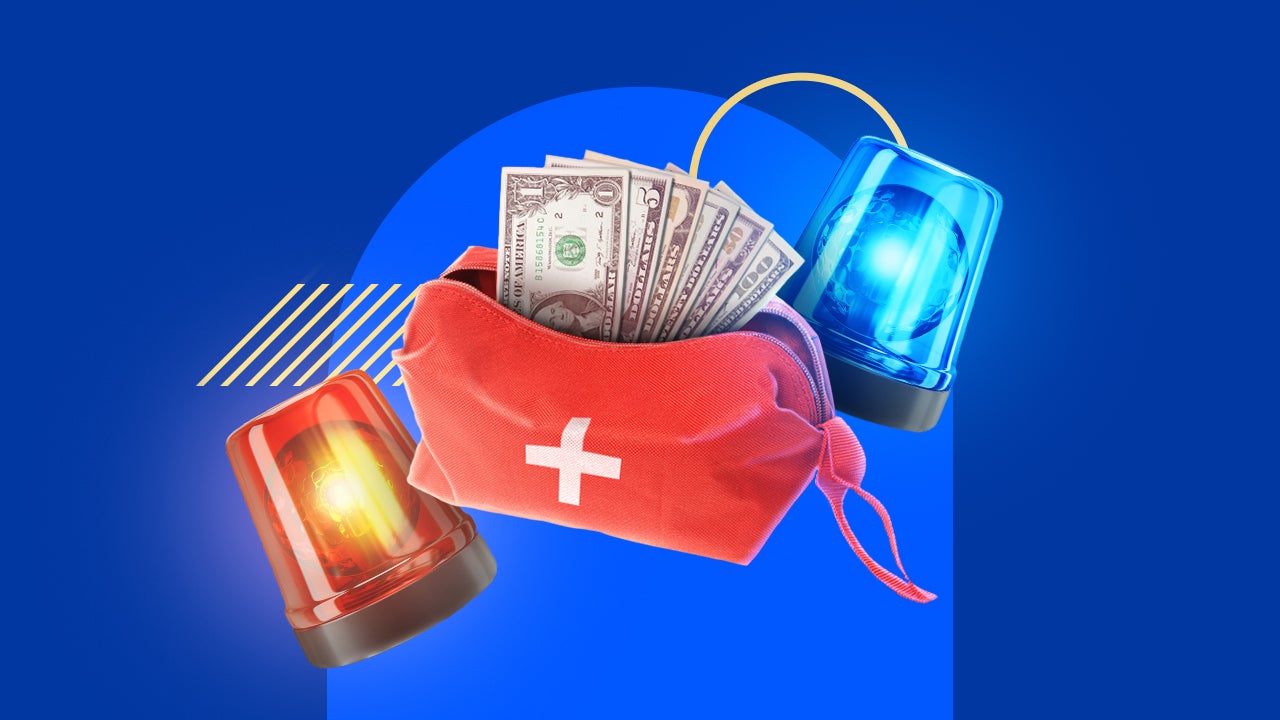The best places to keep your emergency fund




Source: Bankrate’s latest emergency fund report
In addition to saving for highly anticipated goals, such as a dream vacation or a down payment on a home, it’s important to save for the days you hope will never arrive. Unexpected events, such as an emergency room visit or a broken-down car, can result in major financial problems when you don’t have an emergency fund in place.
Having the savings to cover unplanned expenses can help you avoid debt, although only 44 percent of adults said they’d pay an emergency expense of $1,000 or more from savings, Bankrate’s emergency savings report found. It’s especially important to have such a fund given experts are saying there’s a 1-in-2 chance the U.S. economy will enter a recession in 2024.
Having six months’ worth of expenses in an emergency fund is just one part of a successful personal finance strategy; you need to find the right home for it, too. Where you keep your emergency fund should factor in liquidity, protection and interest rates.
The best places to put your emergency savings
You need to be able to sleep at night with the assurance that your emergency fund has no chance of disappearing, so safety is a key ingredient. Two ways you can protect your emergency fund are by looking for an account with Federal Deposit Insurance Corp. (FDIC) coverage and by avoiding high-risk investments.
A good place for your emergency savings is often one that’s earning a competitive rate of return. For instance, high-yield savings accounts are currently earning yields that outpace the rate of inflation — so your money won’t be losing purchasing power. Top high-yield savings accounts commonly earn 5 percent or greater, while the inflation rate in January 2024 was 3.1 percent.
Accessibility is essential, too. Because you may need the money in your emergency stash at a moment’s notice, you’ll want to be able to withdraw funds without any potential for delay or penalties. Here are a few ideal options.
Online savings account or money market deposit account
Both savings accounts and money market accounts offer easy access to your money, while a money market account often also includes some benefits of a checking account such as a debit card and the ability to write checks. Online-only accounts are those offered from banks that operate entirely online, without maintaining branches.
Online savings and money market accounts are both well-suited for your emergency fund. In addition to insurance coverage from the FDIC or National Credit Union Association (NCUA), these accounts offer the most competitive interest rates on savings products. Usually, these accounts also come with a guardrail to limit your spending from them: a maximum of six withdrawals per month.
Online savings and money market accounts also tend to earn higher yields than traditional accounts. That means your emergency fund can grow faster while it’s stored away.
One thing to note: Transfers from a savings account may take one to two days. Look out for transfer times, or keep a portion of your money in an account with more immediate access.
“Your emergency savings needs to be somewhere that you can get to it when needed without penalty, is free from investment loss, and earns a return that gives you a chance of keeping up with inflation,” says Greg McBride, CFA, Bankrate’s chief financial analyst. “A high-yield savings account checks all of these boxes — it is liquid, federally insured, and offers competitive returns to help you maintain your buying power.”
Bank or credit union savings account
You can also consider opening another savings account at your primary banking institution, which simplifies your financial life by keeping everything under one roof, while distinguishing your emergency fund from the one you use for your day-to-day finances.
Banks and credit unions offer similar deposit accounts, although a credit union is often only open to those in a certain community or geographic area. Banks, on the other hand, typically offer their products to everyone. While most banks operate for a profit, credit unions distribute their profits among their members.
However, you may sacrifice the potential for earning interest. Institutions with large networks of brick-and-mortar branches may offer a pittance of yield compared with low-overhead, online-only banks.
Money market mutual fund
These funds present another relatively safe place for emergency funds. Although they don’t come with the guarantee of insurance protection, they are low-risk and easily accessible parking spots for cash. Any interest earnings, though, aren’t much to write home about — a key difference between these and money market accounts.
The worst places to put your emergency savings
Knowing where not to keep your money is an equally important lesson. These places can serve a valuable purpose for your other financial needs, but they aren’t designed for emergency safekeeping.
Checking account
Lumping your emergency savings in with the checking account you use on a regular basis presents the challenge of making it too accessible. It’s better to completely separate savings and everyday finances. Otherwise, you will run the risk of dipping into your emergency stash with the promise that you’ll replenish it when your next paycheck arrives (and the potential to break that promise).
The other major downside is the lack of earning potential. Standard checking accounts offer nominal yields, and frequently, they don’t offer any interest earnings at all.
Certificate of deposit
A traditional CD comes with a penalty for any early withdrawal of the funds. So, if you park your emergency savings in a one-year CD and wind up needing the money in four months, you’ll forfeit interest and, potentially, even have to hand over extra cash to access it. There are alternative no-penalty CDs, but some of these still carry access limitations and often pay less interest.
The stock market
With an average of a 10 percent annual return, the stock market is great for a long-term investment strategy. However, when you have the potential for playing a very short game — needing your money next week, for example — avoid the market at all costs.
If you want evidence of the high-risk gamble that stocks present for your savings, take a look back at the four-day period in March 2020 when the Dow Jones Industrial Average dropped by 26 percent. In 2024, major stock indices have reached record or near-record highs, although gains aren’t always long term as markets react to factors such as Federal Reserve actions, consumer spending and inflation data.
Savings bonds
Savings bonds might work for a portion of your emergency fund. However, there are some significant drawbacks to using them for your safety cushion. After purchasing a savings bond, you cannot cash it in for a full year. And while these do pay interest, you would have to forfeit three months of those earnings if you cash in the bond within five years of purchase.
At home
If you’re considering keeping your emergency fund under a mattress or in a safe at home, it’s time to rethink your strategy. In the event of an at-home emergency such as a fire or theft, it creates another dire emergency: Your cash will be gone — without any way of getting it back.
Plus, you lose out on several of the benefits offered by regulated accounts, such as insurance and the potential to earn a yield.
Bottom line
If you’re struggling to build an emergency fund, it can actually help to find an appropriate place to store the fund. If you keep your fund in a savings account, for example, there’s an incentive to avoid breaking into your savings, since there are often limits on withdrawals you can make from these accounts. It also makes it easier to track savings progress when savings are kept separate from funds for everyday spending.
Plus, when you shop around for the right account, there’s a potential to earn a top-tier interest rate and make your savings grow. Compare some of the best savings accounts and money market accounts as a starting point to find a home for your emergency fund.
Frequently asked questions
-
Storing your emergency fund in a dedicated account can help keep you from dipping into the money for other purposes. Some savings accounts conveniently allow you to set up buckets devoted to different goals such as emergency expenses, a vacation, a new car or a down payment on a house.
-
Checking accounts are designed for transactions such as paying bills or writing checks. As such, your emergency fund may be better off in a separate account where the money generally remains untouched. Checking accounts also tend to earn low (or no) interest, so your emergency fund could earn a higher return in a high-yield savings account.
-
Because cash is paper, it’s subject to becoming damaged from water or fire. For this reason, a fireproof safe is often chosen by people who keep cash at home. A locked safe can also help keep your money or other valuables intact in the event of a burglary.
-
An emergency fund is a source of money for unplanned expenses that can crop up, especially when you’d have to go into debt to pay for these things. Examples include a large medical bill or a major home repair. An emergency fund also comes in handy to help pay your monthly bills in the event of a loss in income.
— Bankrate’s René Bennett and Karen Bennett contributed to updates of this story.
You may also like

Best Index Funds In October 2024

7 ways to save money on home maintenance

